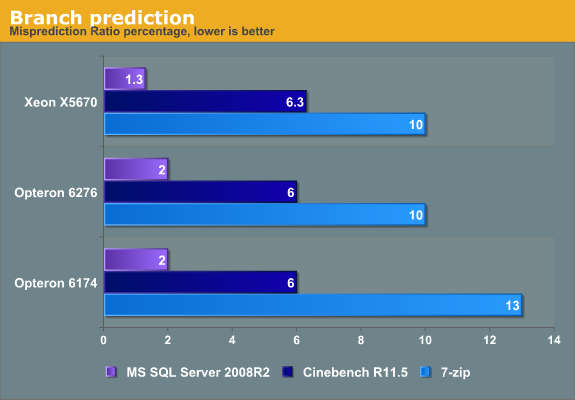The Bulldozer Aftermath: Delving Even Deeper
by Johan De Gelas on May 30, 2012 1:15 AM ESTBranch Prediction Analysis
The AMD engineers overhauled the branch prediction unit(s) completely in Bulldozer. Did they succeed in closing the gap with Intel, which has had superior branch prediction for years now ? Let us see.

The new Opteron's BPU performs at least as good and sometimes significantly better than old one. This is another component that AMD really got right. However, Intel's BPU clearly wins in SQL Server.










84 Comments
View All Comments
Spunjji - Wednesday, June 6, 2012 - link
Agreed. That will be nice!haukionkannel - Wednesday, May 30, 2012 - link
Very nice article! Can we get more thorough explanation about µop cache? It seems to be important part of Sandy bridge and you predict that it would help bulldoser...How complex it is to do and how heavily it has been lisensed?
JohanAnandtech - Thursday, May 31, 2012 - link
Don't think there is a license involved. AMD has their own "macro ops" so they can do a macro ops cache. Unfortunately I can not answer your question of the top of head on how easy it is to do, I would have to some research first.name99 - Thursday, May 31, 2012 - link
Oh for fsck's sake.The stupid spam filter won't let me post a URL.
Do a google search for
sandy bridge Real World Technologies
and look at the main article that comes up.
SocketF - Friday, June 1, 2012 - link
It is already planned, AMD has a patent for sth like that, google for "Redirect Recovery Cache". Dresdenboy found it already back in 2009:http://citavia.blog.de/2009/10/02/return-of-the-tr...
The BIG Question is:
Why did AMD not implement it yet?
My guess is that they were already very busy with the whole CMT approach. Maybe Streamroller will bring it, there are some credible rumors in that direction.
yuri69 - Wednesday, May 30, 2012 - link
Howdy,FOA thanks for the effort to investigate the shortcomings of this march :)
Quoting M. Butler (BD's chief architect): 'The pipeline within our latest "Bulldozer" microarchitecture is approximately 25 percent deeper than that of the previous generation architectures. ' This gives us 12 stages on K8/K10 => 12 * 1.25 = 15.
Btw all the major and significant architectural improvements & features for the upcoming BD successor line were set in stone long time ago. Remember, it takes 4-5 years for a general purpose CPU from the initial draft to mass availability. The stage when you can move and bend stuff seems to be around half of this period.
BenchPress - Wednesday, May 30, 2012 - link
"This means that Bulldozer should be better at extracting ILP (Instruction Level Parallelism) out of code that has low IPC (Instructions Per Clock)."This should be reversed. ILP is inherent to the code, and it's the hardware's job to extract it and achieve a high IPC.
Arnulf - Wednesday, May 30, 2012 - link
Ugh, so much crap in a single article ... this should never have been posted on AT.You weren't promised anything. You came across a website put up by some "fanboy" dumbass and you're actually using it as a reference. Why not quote some actual references (such as transcripts of the conference where T. Seifert clearly stated that gains are expected to be in line with core number increase, i.e. ~33%) instead of rehashing this Fruehe nonsense ?
erikvanvelzen - Wednesday, May 30, 2012 - link
Yes AMD totally set out to make a completely new architecture with a massive increase in transistors per core but 0 gains in IPC.Don't fool yourself.
Homeles - Wednesday, May 30, 2012 - link
It's a more intelligent analysis than your sorry ass could ever produce. Getting hung up on one quote... really?